What are polar patterns?
When browsing for a new studio condenser mic or live vocal mic, you will run into a specification called ‘Polar Pattern’. This will be accompanied by terminology such as ‘Cardioid’, ‘Omnidirectional’ or ‘Bidirectional’ to name a few.
Polar Pattern refers to the sensitivity of a microphone to sounds arriving from different angles from the central axis. Simply put, the Polar Pattern determines at what angle from the microphone capsule sound is able to be picked up and is represented in the familiar circular chart format.
Each polar pattern has a specific application – both live and in the studio – that helps you to record your sound source with the most appropriate pattern available depending on the situation. Understanding how these polar pattern works is therefore essential to get the best of out your sessions.
Certain polar patterns are better for recording singing, drums, guitar, or even live performances. By selecting the right pattern for the job, you could save yourself a lot of work down the line in the mixing stage of your productions.
Getting it right at the source means that you can capture the sound of the room when needed, avoid any unwanted bleed, and alter how much the proximity effect will be heard in your tracks.
What polar pattern should I use?
Although this can be used as a guide by taking into account the characteristics of each polar pattern, there are no hard and fast rules that can be applied that decide what microphone polar pattern you should use on your recordings.
Experimentation is encouraged to find the sound that works for you and your situation. Check out some real-world examples and our recommendations:
When to use omnidirectional:
- To record multiple instruments or singers simultaneously in one microphone such as choirs, orchestras, podcasts or interviews.
- When recording instruments that require a large amount of room ambience to add depth and realism such as pianos or acoustic guitars.
- Capturing a moving sound source for consistent frequency response and level such as a stage production.
When to use Figure of 8 / Bidirectional:
- When recording a conversation between two presenters for a broadcast or podcast to capture both voices simultaneously.
- For stereo recording when two microphones are paired together in the Blumlein technique, this can be ideal for recording overhead microphones for percussion or acoustic drums
- To record two sound sources in close proximity simultaneously such as a singer-songwriter’s acoustic guitar and vocals.
When to use Cardioid:
- For live performances when you need to isolate your sound source from surrounding instruments (particularly live singing) and eliminate feedback.
- Studio vocal recordings to isolate your singing from unwanted room ambience to get a focussed sound.
- Close-micing acoustic drums shells to isolate your kit to reduce bleed to help mix your drums more accurately.
When to use Supercardioid:
- Recording in rooms with poor acoustic treatment to help minimise unwanted ambient reflections that can spill into your recording.
- Recording high-gain electric guitars to eliminate room reflections for a tight sound with no distracting room sound
- Close-micing snare drums to effectively eliminate bleed from problematic hi-hat cymbals.
When to use Hypercardioid:
- When precise microphone techniques are required with no movement from the sound source, such as field recording documentaries.
- Micing drums on a busy stage
Now that you have a basic understanding of the polar pattern types, let’s dive deeper into each one to really get to grips with them…
What is Omnidirectional?
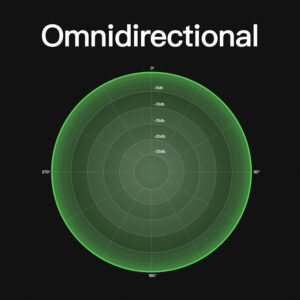
Omnidirectional (or Omni for short) has the same sensitivity from any direction and picks up sound evenly around the microphone. This means that it picks up sound uniformly around the microphone in a full 360-degree sphere, making it the easiest to understand and easiest to plot on a graph and diagram.
A result of this is that you don’t necessarily need to point the front of the microphone towards your sound source as in theory the gain level and frequency response won’t alter even if placed on an angle towards your sound source.
Typically, Omnidirectional patterns will be most commonly found on clip-on lavalier and headset microphones for on-stage performers. This ensures that with every head movement away from the microphone, the volume level and frequency response won’t be altered, producing a consistent sound.
However, it’s not exclusive to these microphone types and will often be found on large diaphragm condenser microphones that feature switchable patterns.
In the studio, using an Omni polar pattern is incredibly functional as it does not suffer from any proximity effects due to the linear response around the microphone. This means that for singers, you won’t suffer from any plosive ‘p’ or ‘b’ sounds – resulting in smooth recordings.
An important note when using an Omni mic for recording is the 360-degree sensitivity means that you will hear everything in close proximity to the sound source. This could potentially include things you don’t want to hear, such as AC fan systems or mechanical computer noises.
What are the benefits?
- A smaller number of microphones needed to capture large sound sources
- Provides the best bass response and flattest frequency response around the microphone capsule
- Picks up high frequencies with more directivity for more even response around the microphone
- Won’t suffer from any proximity effect
- Least sensitive to handling noise
- Natural and realistic audio that records important ambient information
- Ideal for capturing two sources simultaneously such as interviews, podcasts or meetings
- Excellent for theatre performers using clip-on lavalier and headset microphones as it allows you to move your head naturally without altering the sound or volume
Microphone examples:
Typically come in the form of headset microphones and boundary microphones, but a lot of large-diaphragm condensers will have switchable patterns.
- Rode Lavalier Microphone Omni Directional Lapel Mic
- Shure Centraverse CVB-B/O Omnidirectional Boundary Microphone
- SubZero SZC-800 Condenser Microphone with Switchable Polar Patterns
- Aston Microphones Spirit Multi-Pattern Condenser Microphone
- AKG C414XL II Condenser Microphone
What is Figure of 8 / Bidirectional?
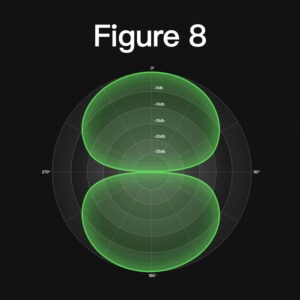
A Bidirectional microphone (commonly referred to as Figure of 8) picks up sounds equally from the front and back of the microphone and rejects sounds from the sides.
Designed as a ‘pressure-gradient’ capsule, Bidirectional mics respond to air pressure between the front and back of the microphone. This means that sound sources on the side angles of 90-degrees and 270-degrees from the front create equal pressure on the front and back, and therefore will become ‘nulled’, resulting in complete rejection.
The figure of 8 polar pattern is most commonly found in ribbon microphones due to the ‘pressure-gradient’ capsule design that exposes both sides of the microphone to sound pressure.
Figure of 8 polar patterns can be extremely useful when recording in the studio. When two figure of 8 polar patterns are paired together, it can be used to great advantage for stereo recording techniques such as Mid/Side recording and Blumlein recording.
When using the Mid/Side recording technique, you will see a much more symmetrical exposure of sound pressure to create a ‘true bidirectional’ polar pattern, where both sides of the microphone are captured more evenly.
What are the benefits?
- Ideal for recording broadcasts, podcasts or interviews between two people with one single microphone
- Use Blumlein or Mid/Side recording techniques
- Nulls any sound from the side, making it ideal for rejecting any bleed from side sound sources
- Capture room ambience for more authentic and natural recordings
- Less proximity effect than cardioid patterns
Microphone examples:
Traditionally used in tube and ribbon microphone design due to the pressure gradient capsule type.
- SubZero R1 Ribbon Microphone
- Rode NTR Ribbon Microphone
- Coles 4038 Studio Ribbon Microphone
- Warm Audio WA-67 Tube Microphone
- Royer R-121 Studio Ribbon Microphone
What is Cardioid?
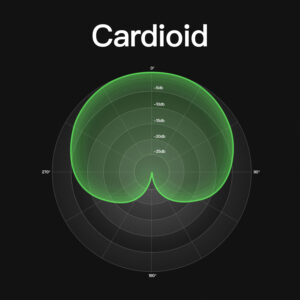
The Cardioid polar pattern is the most common polar pattern on microphones and is a 1:1 combination of Omnidirectional and Bidirectional. The combination of these two polar patterns creates a heart-like pattern (where the term ‘cardio’ originates for this pattern) when plotted on a 360-degree sphere.
Cardioid polar pattern is more directional and sensitive to the front of the microphone in the on-axis position, with a decrease in sensitivity towards the sides and a null point in the rear of the microphone.
As alluded to earlier, cardioid polar patterns are the most common polar pattern for microphones and can be found on everything from small-diaphragm condensers, large-diaphragm condensers, dynamic, lavalier and even USB microphones.
Typically, most vocal microphones designed for both live and in the studio use this polar pattern, as it allows you to pick up directly what’s in front of you. It also rejects sound from the back with reduced sensitivity and volume in the sides, effectively eliminating any potential feedback from other instruments or equipment.
As cardioid polar patterns are most sensitive to the on-axis position with a null point in the 180-degree angle, they can display an excellent gain-level ability. In the studio, cardioid polar patterns allow you to use dial in more gain for extra volume without suffering from feedback, making it ideal for instruments with lots of dynamic range.
What are the benefits?
- Ideal for most recording applications
- Highest rejection at the rear greatly reduces bleed from sources behind your microphone
- Isolates the microphone from unwanted ambient sounds
- Puts your sound source at the front and centre with a focussed sound
- Excellent for on-stage sound to reduce bleed and feedback
- Can be used in pairs to create stereo X/Y recordings
Microphone examples:
Found in most dynamic microphones for a ‘point and record’ experience.
- Shure SM57 Dynamic Instrument Microphone
- SubZero SZM-11 Dynamic Vocal Microphone
- AKG D112 MKII Kick Drum Microphone with Flexible Mount
- Sennheiser MD 421 II Dynamic Instrument and Vocal Microphone
- Electro-Voice RE20 Dynamic Cardioid Microphone, Black
What is Supercardioid?
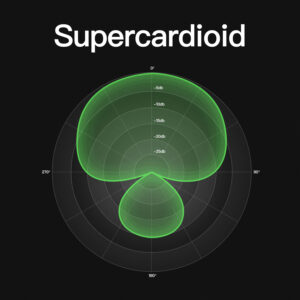
The supercardioid polar pattern is a deviation from the cardioid polar pattern with an even tighter directionality.
The on-axis directionality of a supercardioid polar pattern is reduced, meaning the side sensitivity and volume level at 90 and 270-degrees is also reduced. The trade-off for this front-facing directivity is an increase in volume towards the rear of the microphone at 180-degrees. In this instance, supercardioid is roughly a 5:3 ratio of omni and bidirectional patterns combined.
The lobe on the rear of the polar pattern at 180-degrees means that, unlike cardioid microphones, supercardioid microphones will have a small amount of level picked up from the rear of the microphone. This should be taken into careful consideration for use in the studio when multi-micing a large sound source such as a drum kit.
Typically, supercardioid patterns are reserved for microphones specifically designed for drums or vocal recordings to isolate the sound source from external noises and ambience for a focussed tone, whilst rejecting bleed from other instruments.
Due to the directivity of supercardioid microphones however, they can often be susceptible to vocal plosives and the proximity effect, where by ‘b’ and ‘p’ sounds are pronounced and will become louder as the microphone gets closer to the sound source.
What are the benefits?
- Perfect for live singers for increased gain sensitivity with less chance of feedback
- Rejection of side sources creates a very dry recording, excellent for mixing with effects in post-production
- Effectively eliminate side-facing sound sources
- Captures a small amount of rear sound for added depth to your sound
Microphone examples:
Typically found on microphones specifically designed for drums or vocals.
- Shure Beta 57A Dynamic Microphone
- Shure Beta 52A Bass Drum Microphone
- sE Electronics V Beat
- AKG C7 Reference Condenser Microphone
- Behringer BA 85A Dynamic Super Cardioid Microphone
What is Hypercardioid?
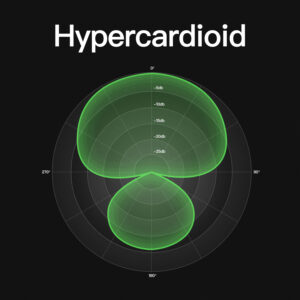
Much like supercardioid, hypercardioid exhibits the same polar pattern shape, with an even narrower range of on-axis directivity and a greater reduced sensitivity in the sides at 90 and 270-degrees.
The null points of hypercardioid are observed at a greater distance away from the microphone axis at 110 and 250-degrees. Important to note that with hypercardioid polar patterns, there is again a lobe at the rear of the microphone capsule at 180-degrees that is more sensitive than supercardioid microphones.
When drawn in a diagram showing sensitivity around the microphone, hypercardioid is roughly a 3:1 ratio of bidirectional and omnidirectional combined together.
Similar to supercardioid, hypercardioid microphones are typically reserved for specific drum microphones to isolate the sound source from external sources and reduce bleed from adjacent instruments.
It is however common for many large-diaphragm condenser microphones to have a selectable hypercardioid pattern that makes use of two pressure-grade capsules that capture on both sides of the diaphragm.
What are the benefits?
- Sensitive to microphone placement, allowing you to get more precise recordings
- Extremely narrow capturing pattern, nulling side-facing sound sources effectively
- The most resistant to on-stage feedback
- Captures a larger amount of rear information, giving more depth and ambience to dry recordings
Microphone examples:
Microphones specifically designed for drums typically feature hypercardioid patterns.
- Audix D2 High Gain Percussion Dynamic Microphone
- Audix D4 Low-Frequency Dynamic Instrument Microphone
- AKG C414 XLS Condenser Microphone
- Audix OM5 Dynamic Vocal Microphone, High Output
Alternative patterns
There are of course some outliers to the main polar patterns found on recording microphones that are not as common in popular recording techniques or studio techniques, but can still be very functional in your recordings.
Subcardioid
Follows the same pattern as omnidirectional, however with a reduced sensitivity from the back of the microphone. With Subcardioid, you can still pick up frequencies more even around the microphone, but it will have a reduced input from the back of the microphone, resulting in a louder signal from the front of the microphone.
Shotgun (Lobar)
An extremely directional pickup with a drastic fall-off in the wings, but has small lobes on the sides of the microphone at 90 and 270 degrees with a less pronounced sensitivity on the rear. Typically used for voice recordings of film and TV sets to effectively eliminate any extraneous environmental noises.
Stereo
Makes use of at least two diaphragms that are set up to output two or more mono signals simultaneously, that can be merged in your recording interface to create a true stereo signal. Typically, stereo microphones are comprised of two or more bidirectional or cardioid polar patterns to capture the direct source as well as ambient information around the microphone.
Multi-pattern microphones
While many manufacturers make microphones to a defined specification, there are plenty of recording microphones available that feature multiple patterns to allow you to experiment and face any challenge thrown your way. Check out these examples that cover a wide range of budgets:
- SubZero SZC-800 Condenser Microphone with Switchable Polar Patterns
- Rode NT2-A Studio Solution Pack
- sE Electronics sE-4400A Studio Condenser Mic
- AKG C414XL II Condenser Microphone
- Blue Kiwi Cardioid Condenser Microphone
Spoilt for choice?
There is one special case, an anomaly within studio recording and specifically polar patterns that could potentially pave the way for a new way to create microphones…
The Austrian Audio OC818 – a revolutionary microphone that can do it all in a way you’ve likely never seen before. With the Austrian Audio OC818 you can digitally change the polar pattern of your recorded signal in post-production with their free to download PolarDesigner software.
It remains to be seen whether more microphone designers seek to utilise this technology in the future, however it proves to be an extremely useful and functional part of the recording process and could change the way you view recording techniques.
Find out more
Now that you’re armed with all the information you need, why not check out our extensive offering of live and studio mics to add to your microphone locker.
Shop now | Studio Microphones
Shop now | Live Microphones

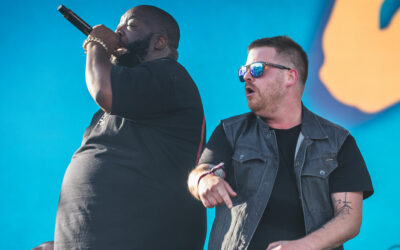
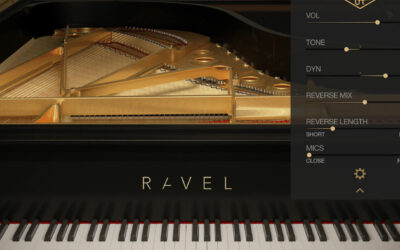
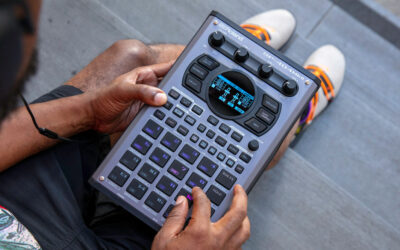

0 Comments